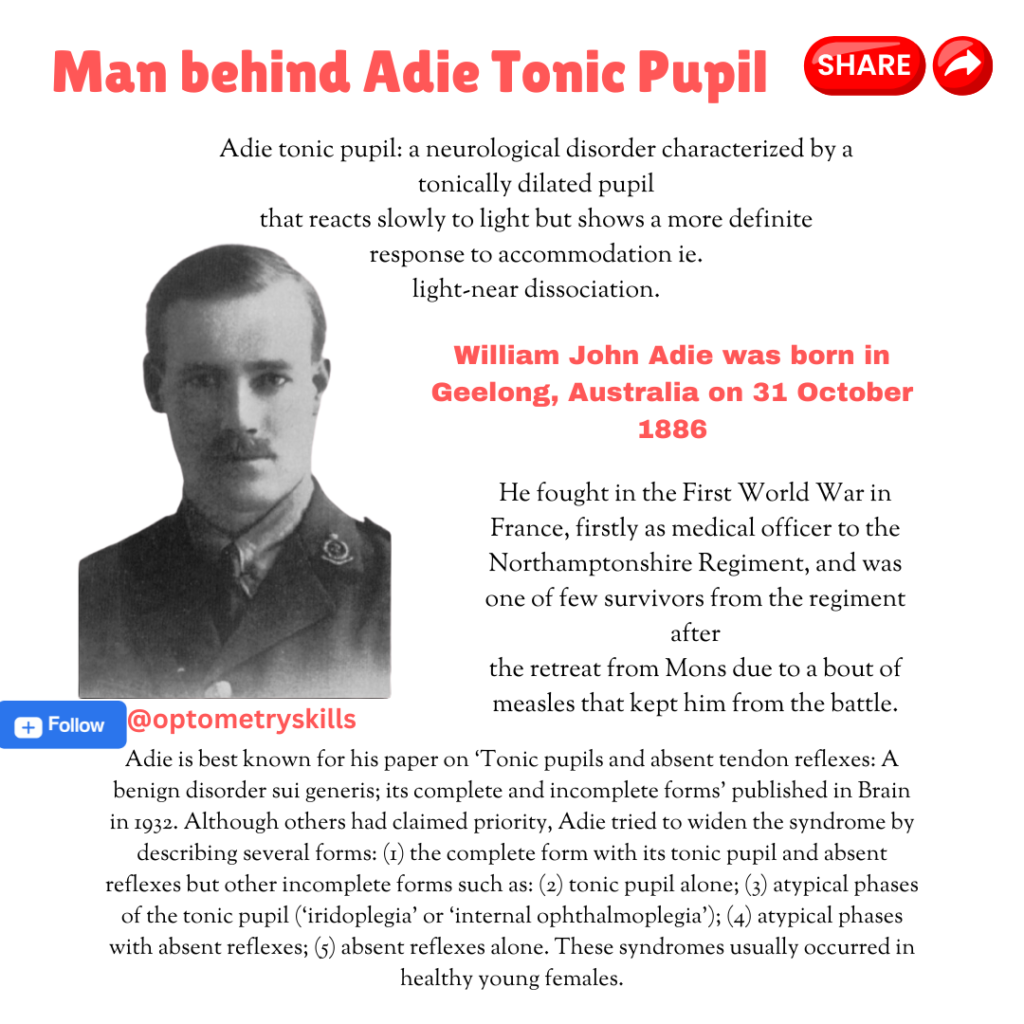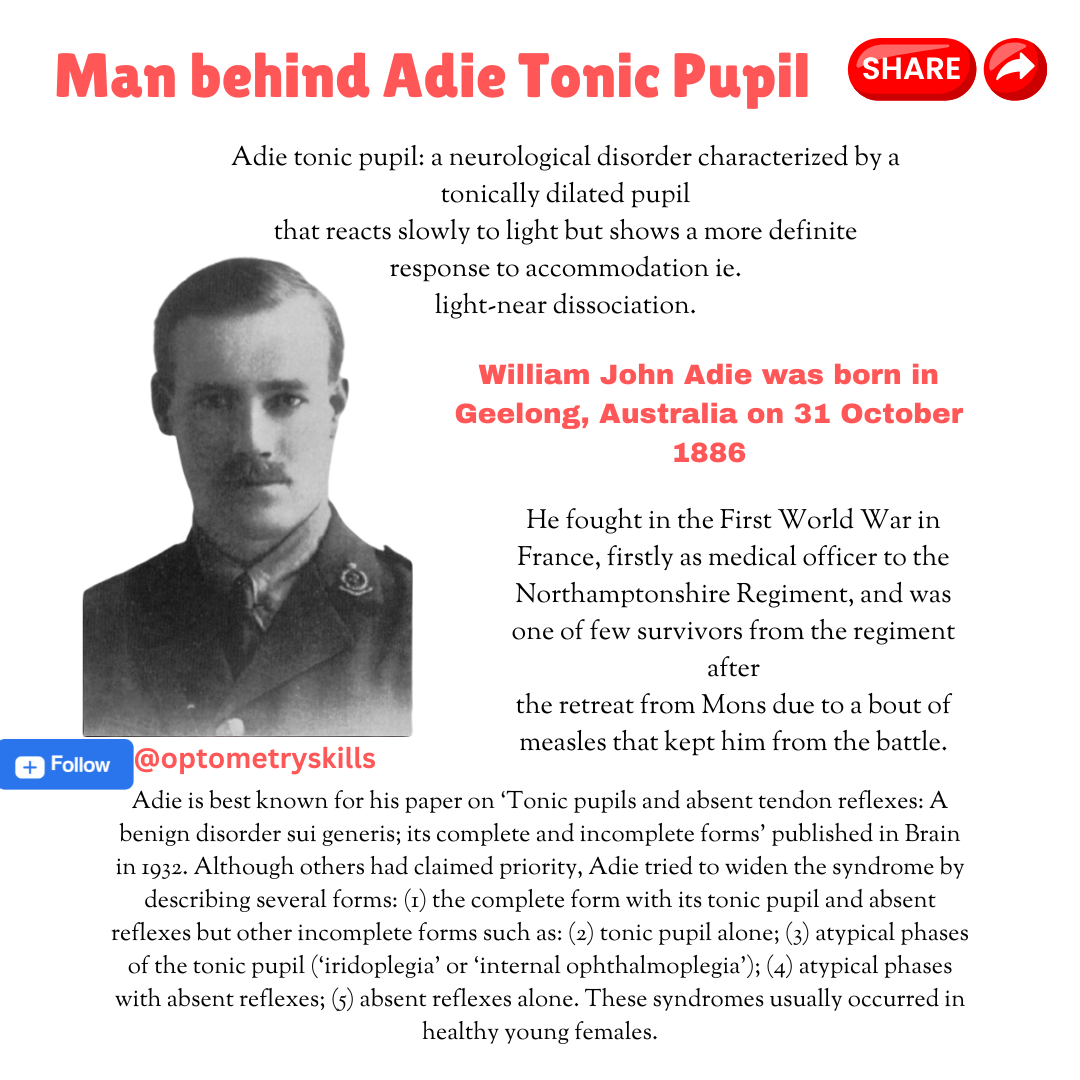William John Adie (1886 – 1935): The Neurologist Behind Adie’s Tonic Pupil

Imagine a bright, young boy in Australia, forced by circumstances to leave school and work as an errand boy to support his family. Despite hardships, he rises to the pinnacle of his field in a foreign land, contributing immensely to neurology and leaving a legacy that lives on through a rare eye condition. This is the story of Dr. William John Adie—a story of resilience, brilliance, and dedication.
Early Life and Inspiration
Born in Geelong, Australia, on October 31, 1886, William John Adie faced tough circumstances early on. When his father passed away in 1899, young Adie, just 13, had to leave school to work as an errand boy to help his family make ends meet. But his potential didn’t go unnoticed. An employer saw promise in him and sponsored his evening classes, which eventually allowed Adie to pass the university entrance exams—a remarkable feat considering his lack of formal schooling.
A local doctor, Dr. Arthur South, further ignited Adie’s interest in medicine. With encouragement and support, Adie pursued his dream. He set sail to the U.K., with a one-way ticket paid for by his uncle in Boston, and enrolled in the University of Edinburgh to study medicine, which he completed in 1911.
Medical Journey and War Service
Adie’s path led him toward neurology, a field that would become his specialty. After graduation, he trained in cities across Europe, including Berlin, Vienna, Munich, and Paris, gaining knowledge from leading experts of his time.
When World War I broke out, Adie joined as a medical officer for the Northamptonshire Regiment, facing the horrors of the front lines in France. Ironically, a bout of measles saved him from one of the regiment’s bloodiest battles, as he was unable to participate due to his illness. Later, serving with the Leicestershire Regiment, Adie gained recognition for his quick thinking during a gas attack, improvising a makeshift gas mask by soaking cloth in urine, a method that saved several soldiers. For his bravery, he received mentions in official dispatches.
Post-War Contributions to Neurology
After the war, Adie returned to England, where he served as a registrar at Charing Cross Hospital and later joined the prestigious National Hospital for Nervous Diseases and Moorfields Eye Hospital in London. Here, he developed a reputation as an exceptional teacher and diagnostician, known for his remarkable observational skills. His reputation was so strong that he was once able to diagnose a rare brain infarct over the phone—an impressive testament to his expertise.
In 1926, Adie’s contributions were formally recognized when he became a Fellow of the Royal College of Physicians and received the prestigious gold medal for his M.D. from the University of Edinburgh. Just a few years later, in 1932, he co-founded the Association of British Neurologists, which remains a significant organization in the field today.
The Discovery of Adie’s Syndrome
Adie’s most notable contribution to neurology was his research on a neurological disorder now known as “Adie’s Tonic Pupil.” This condition, identified by a pupil that remains unusually dilated and reacts slowly to light but adjusts more noticeably during close focus (a phenomenon known as light-near dissociation), is often seen in healthy young women. Adie’s research, published in his 1932 paper, Tonic Pupils and Absent Tendon Reflexes: A Benign Disorder Sui Generis, described different forms of the condition, including cases involving absent reflexes.
A Lasting Legacy and Personal Life
William Adie’s life extended beyond medicine. He was known for his warmth, humility, and passion for ornithology, tennis, and skiing. He had a considerable private practice in Brook Street, near the famous Harley Street area in London, where he lived in a lovely terrace house overlooking Regent’s Park. His life, though, was cut short due to angina, leading to his untimely death on March 17, 1935, at just 49 years old.
Today, Adie’s legacy lives on not only through his contributions to neurology but also as a symbol of resilience and dedication. His journey from errand boy in Australia to a distinguished neurologist in the U.K. is a reminder of how far passion, hard work, and a bit of encouragement can take you. Adie’s life story and his enduring medical discoveries continue to inspire those in the field of neurology and beyond.
-Hall of Fame
Discover more from An Eye Care Blog
Subscribe to get the latest posts sent to your email.


You must be logged in to post a comment.